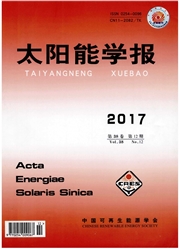

 中文摘要:
中文摘要:
以定量滤纸为纤维素模化物,在3种超低酸浓度和4种温度下进行了马来酸水解的多点取样实验,以还原糖收率为指标得到较佳工况,并进一步通过间歇实验确定酸浓度0.1%、液固比20:1、温度220℃、压力4MPa、搅拌速率500r/min、反应时间55min为较优工况,可得到还原糖收率、还原糖转化率和原料转化率分别为32%、66%和48%。硫酸水解的较佳工况比较,发现马来酸存在下还原糖降解较弱,糠醛类的相对含量比硫酸存在时减少24.57%(48.22%:72.79%)。马来酸水解纤维素产糖多为聚糖;残渣依然具有纤维素特性,但结晶度较原料降低17%,对后续的酶解及发酵有利。
 英文摘要:
英文摘要:
Multi-point sampling tests of hydrolysis of quantitative filter paper were approached with maleic acid catalyst under three different extremely low concentrations and four different temperatures. Targets for reducing sugar yield, the better condition was obtained, and through batch experiments, the combination of 0. 1 % acid concentration, 220℃, 4MPa, 500r/min, and 55min were deemed as the optimal condition, and the reducing sugar yield, conversion ratios of reducing sugar and feedstock was 32%, 66% and 48%, respectively. Compared to the results of better condition under extremely low sulfuric acid, it was found that there is less sugar degradation using extremely low maleic acid, and the relative content of furfural category is 24.57% less than that under extremely low sulfuric acid (48.22% vs. 72.79% ). Maleic acid hydrolysis results in more polysaccharide; the hydrolysis residue still maintains the characteristic of cellulose, with lower crystallinity of 17% than feed, indicating benefits for enzymolysis and fermentation.
 同期刊论文项目
同期刊论文项目
 同项目期刊论文
同项目期刊论文
 Two-step liquid hot water pretreatment of Eucalyptus grandis to enhance sugar recovery and enzymatic
Two-step liquid hot water pretreatment of Eucalyptus grandis to enhance sugar recovery and enzymatic 期刊信息
期刊信息
